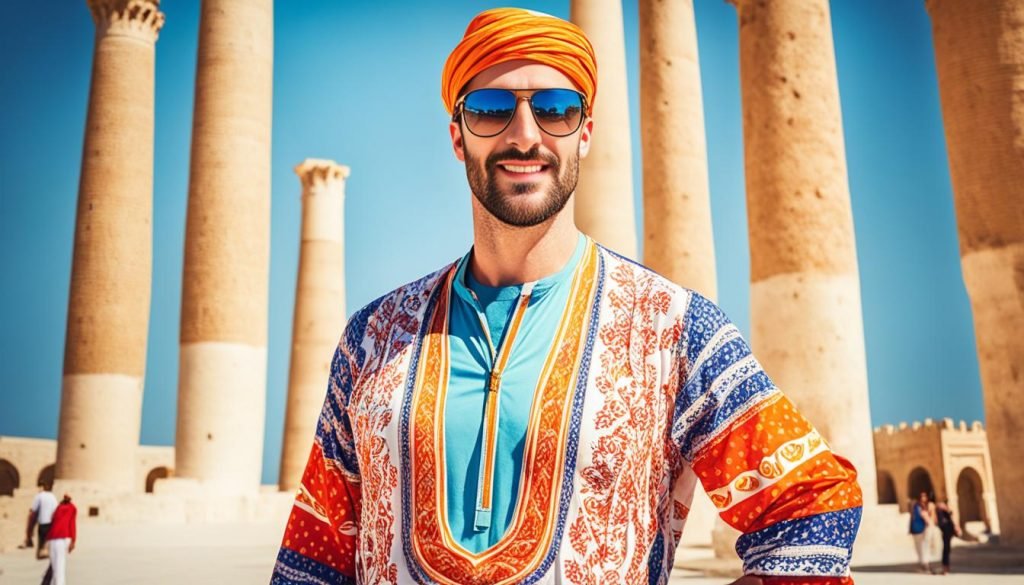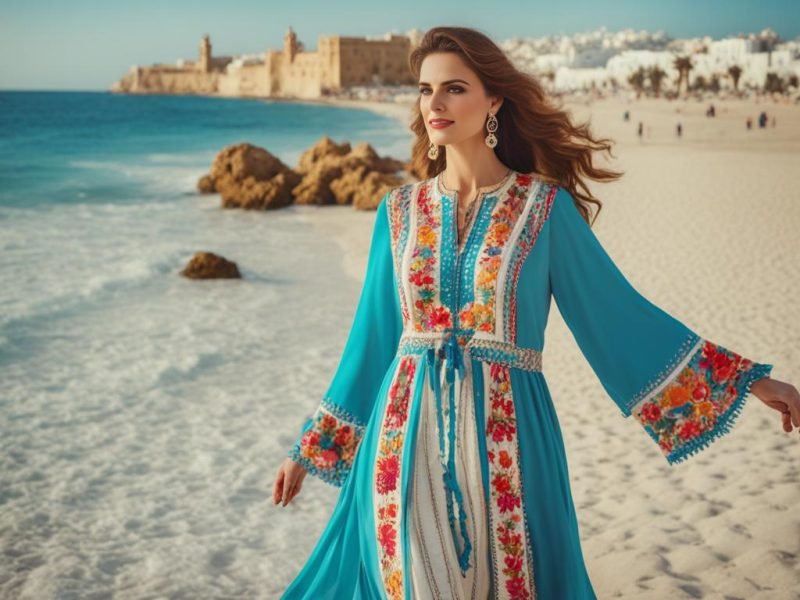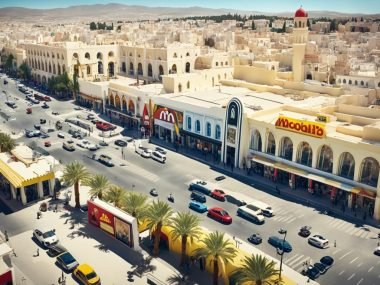I’ve always seen clothes as more than just what we wear; they’re a way of showing who we are. They let us silently join in with the culture we’re visiting. Thinking about what to pack for Tunisia, I wondered, ‘Can I Wear Shorts in Tunisia?’ This question made me think more about being respectful, open, and connecting with people through travel. I learned that respecting the dress code in Tunisia opens doors to amazing experiences. Dressing considerately shows you’re a guest who values the country’s heritage and warmth. For those exploring this beautiful Mediterranean place, choosing what to wear is finding a middle ground between comfort and being culturally sensitive.
When learning about travel in Tunisia, it’s clear how important it is to understand the local culture, which is influenced by Islam. Even though I wasn’t told I couldn’t wear shorts, I felt it was better to dress modestly. Understanding what to wear is a big part of becoming a respectful traveller. It’s how you show you value Tunisia’s culture.
Key Takeaways
- Considering the cultural norms of a destination is key to respectful travel.
- Understanding and adhering to the local Tunisia dress code enhances cultural experiences.
- Learning about cultural clothing in Tunisia allows travellers to pack appropriately for their journey.
- The question of ‘Can I Wear Shorts In Tunisia?’ reflects broader themes of modesty and respect.
- Seeking Tunisia travel tips before departure ensures preparedness for cultural expectations.
Understanding Tunisia’s Clothing Norms
When planning your outfits for Tunisia, consider the climate and cultural expectations. Summer clothes should be cool but also modest. In cities like Tunis, fashion mixes traditional and Western styles elegantly.
In smaller towns and the south, the dress code is more conservative. To fit in and respect local culture, follow Tunisia’s fashion rules. This ensures a respectful visit. Here’s how to blend in well:
- For daytime outings: Choose breathable fabrics that cover shoulders and knees.
- In cosmopolitan areas: Feel free to experiment with contemporary styles keeping modesty in mind.
- While exploring rural regions: Opt for attire that offers more coverage to respect local customs.
Dressing with respect shows you value local traditions. It also makes your stay more comfortable and enjoyable in Tunisia.
Navigating Cultural Attire in Tunisian Society
In Tunisia, the clothes people wear show a lot about the culture. Dressing in Tunisia is not just about looking good. It shows respect for old traditions and the community’s identity. Knowing and following local dress rules is key to honouring these traditions. It makes your visit both enriching and respectful.
Respecting Local Traditions
In many Tunisian places, especially outside big cities, what you wear matters a lot. To truly connect with locals, wearing the right clothes is vital. Advice from experienced travellers and locals is to dress with local customs in mind. This shows respect and helps blend in.
The Impact of Clothing on Social Dynamics
Clothes are a powerful way to communicate. In Tunisia’s south and its smaller towns, the right clothes help you fit in. Wearing the wrong thing can make you feel out of place or show disrespect. Dressing modestly is not only polite but also keeps you safe from theft and unwanted attention.
| Region | Preferred Attire | Notes |
|---|---|---|
| Urban Areas (e.g., Tunis) | Contemporary yet modest | Fashion mirrors Western styles within the bounds of modesty. |
| Rural Areas | Traditional and conservative | Garments are more conservative, with an emphasis on coverage. |
| Tourist Resorts | Leisurewear with decorum | More relaxed rules but with respect for local customs outside of the resort. |
| Southern Regions | Conservative with headscarves often seen | Clothing choices tend to be directly correlated with social acceptance. |
Through my travels in Tunisia, I’ve learnt a lot about the importance of dress. Dressing according to local rules shows respect and enriches your journey. It’s a way to truly appreciate and understand the local culture.
Dress Code Guidelines for Women Travellers
When you travel to Tunisia as a woman, deciding what to wear can be enriching. It’s about meeting local modesty standards while staying comfortable in the North African sun.
What Works Well in Tunisia
For my trips to Tunisia, I choose summer outfits that respect local culture and climate. Jeans, loose pants, and flowy tunics have worked well for me. They are fashionable and respectful. Skirts and shorts at knee-length or longer are fine too, especially with shirts that cover more.
The way you combine clothes is key. Adding a light cardigan or shawl to shorts creates an adaptable look. This versatility in Tunisia outfits makes cultural immersion smoother.
Attire to Avoid for Respectability
Despite Tunisia’s relaxed dress code, some items are best avoided. Revealing tops, very short shorts, and tank tops might not be the best choice. When visiting sacred places, like Kairouan, covering your head matters. So, having a scarf is smart and respectful.
Here is a straightforward guide on what to wear in Tunisia for women travellers, to help you pack right:
| Favourable Attire | Items to Avoid |
|---|---|
| Jeans and slacks | Revealing tops |
| Longer skirts and shorts | Very short shorts |
| Tunics and conservative shirts | Tank tops |
| Headscarf (optional for specific contexts) | Tight or transparent clothing |
Choosing modest, practical clothes helps you feel comfortable across Tunisia. From the hot edges of the Sahara to the Mediterranean’s cool winds, you’ll be prepared.
What Men Should Consider When Dressing in Tunisia
When heading to Tunisia, pack for both the weather and culture. Aim for a look that is both neat and relaxed. Dressing smartly isn’t a must, but being tidy helps everywhere. Many ask, “What to wear in Tunisia?” I found that choosing modest clothing shows respect for the local dress code.
In Tunisia, men often wear jeans and short-sleeve shirts. This is a good style for travellers to copy. Make sure your shorts are knee-length. Pair them with casual shirts for both comfort and adherence to local norms. A key tip: avoid very short shorts and sleeveless tops like tank tops, as they are not well-received outside beach areas.
| Recommended Attire | Attire to Avoid |
|---|---|
| Knee-length shorts | Sports shorts or excessively short shorts |
| Short-sleeve shirts | Tank tops and muscle shirts |
| Jeans or slacks | Any clothing revealing chest hair in public |
| Closed-toe shoes | Flip flops in urban areas |
Showing chest hair in places other than the beach is often seen as rude. Keep this in mind when picking out clothes. This way, your outfits will respect local customs and show cultural sensitivity.

Understanding Tunisia’s clothing norms is about making slight adjustments. It’s finding a balance between your comfort and respecting traditions. When deciding what to wear in Tunisia, aim for comfort and modesty. Consider the impression you wish to leave as a respectful visitor. A few carefully chosen items can make your stay both enjoyable and respectful of the culture.
Seasonal Influence on Tunisia’s Dress Expectations
In Tunisia, the seasons greatly affect Tunisia summer outfits and dressing rules. The Mediterranean climate requires clothes for both hot summers and cool winters.
In summer, it’s wise to wear light, airy fabrics. Cottons and linens are ideal, blending comfort with modesty. Winter calls for layers, like jeans and jumpers, to stay warm but respectful of local customs.
In areas valuing tradition, dressing modestly is always in fashion. This means covering arms, legs, and shoulders, especially at religious sites. It’s a rule that applies all year round.
| Season | Ideal Attire for Men | Ideal Attire for Women |
|---|---|---|
| Summer | Lightweight trousers, knee-length shorts, short-sleeve shirts | A-line skirts, capri trousers, blouses with elbow-length sleeves |
| Winter | Jeans, long-sleeve shirts, sweaters | Long trousers, tunics, layered tops with cardigans |
| Religious Sites | Long trousers, shirts covering shoulders | Skirts or trousers covering the ankles, tops that cover the arms and shoulders, optional headscarf |
Choosing what to wear in Tunisia means considering the season and local culture. Dress with respect, curiosity, and readiness for the climate of this vibrant North African country.
General Advice for Both Men and Women on Tunisia Attire
When you’re packing for Tunisia, choosing the right clothes is key to enjoying your trip. It’s important to think about the hot sun and local traditions. Here’s some advice to help you pick clothes that are both comfortable and respectful.
Footwear Tips for Comfort and Cultural Consideration
For walking through Tunisia’s varied landscapes, sturdy shoes are best. In historic places like Carthage, you’ll be glad you have them. But when it’s really hot, sandals are a must for keeping cool. Avoid high heels and flip-flops as they’re not great for walking on Tunisia’s uneven ground.
Adapting to Climate and Local Fashion Styles
Keeping cool in Tunisia’s heat while still looking good is definitely possible. Look for clothes made of light, airy fabrics. And why not add a bit of Tunisia’s colourful style to your outfits? A few local accessories can really make your look pop.
To get the most out of your trip, blend comfort with respect for Tunisia’s culture. Think carefully about your clothing choices. They should show respect for local customs and reflect the rich tapestry of Tunisian life. Creating such a wardrobe is a way to honour Tunisia’s vibrant culture.
Dressing for Different Regions and Occasions in Tunisia
My travels across Tunisia have taught me a lot. The setting sun does not calm the vibrant local markets or busy tourist streets. For each place and event, Tunisia fashion guidelines advise adapting our clothes. This is a lesson in cultural respect and versatility.
In Hammamet’s coastal areas, the vibe is laid-back, welcoming an international crowd. There, it’s common to see shorts and sundresses. Swimwear is a norm by the beaches. But, I always cover up before hitting the town, respecting local dressing rules in Tunisia.
Villages off the beaten path require more modesty. There, I opt for a full swimsuit with covered shoulders. It’s perfect for a dip in the pool. Then, adding a stylish sarong or palazzo pants makes me market-ready. For those wondering what to wear in Tunisia at souks or historic sites, a light headscarf helps. It shows respect and protects from the sun.
- Pack light cotton or linen clothing for daytime outings. They’re cool and respectful.
- Choose swimsuits with more coverage for quieter areas.
- Keep a light cardigan or jacket handy for cooler evenings.
The evening brings cooler breezes. A light jacket or cardigan becomes essential. They’re perfect for dining outside or a twilight stroll in the medina.
Dressing right in Tunisia depends on timing and location. By following these practices, I fit in well. Whether by the sea or in a village, I maintain a look that’s both right and stylish. This is how I blend Tunisia fashion guidelines into my journeys.
Beach Attire: Balancing Comfort and Conservatism
When in Tunisia, beach clothing is a sensitive matter. It’s about feeling comfortable while respecting local traditions. Men and women need to consider the cultural context, especially near the sea.
What Men and Women Should Wear to the Beach
In Tunisia, picking the right beach clothes is crucial. Men usually wear knee-length swim shorts with a T-shirt. Women feel comfortable in bikinis in resort areas. Yet, adding a sarong or kaftan when strolling or visiting cafes is polite and trendy.
| Beach Attire | Men | Women |
|---|---|---|
| Swimwear | Knee-length swim shorts | Bikini (with cover-up for public areas) |
| Cover-ups | T-shirt or beach shirt | Sarong or kaftan |
| Footwear | Flip-flops or sandals | Flip-flops or sandals |
| Accessories | Sunhat and sunglasses | Sunhat, sunglasses and a beach tote |
Understanding Swimwear Etiquette in Touristy Areas Versus Local Spots
In tourist spots, swimwear rules are more relaxed. But, you’ll still need a cover-up when heading into town. In less touristy areas of Tunisia, women prefer more modest swim attire like a one-piece. The key is finding a balance between being respectful and comfortable. Knowing what to wear in different settings enriches your travel experience in Tunisia.

Why Modesty Matters: Cultural Sensitivity and Clothing
While walking through Tunisia’s lively streets, modesty in clothes isn’t just about fashion. It shows respect for the culture. Wearing outfits that match the Tunisia dress code let me connect with the locals respectfully. Even though there are no strict laws for visitor attire, choosing to respect Tunisia’s clothing norms is key.
In my travels, from ancient Carthage to Tunis’s busy markets, wearing modest clothes helped me blend in. This choice not only honoured local feelings but also made social interactions smoother. The mix of cultural clothing in Tunisia, combining traditional and modest modern styles, looks elegant. It suits Tunisia’s warm weather and Islamic culture beautifully.
- Respecting local dress codes earns you genuine respect from the locals.
- Wearing clothes that are loose and cover shoulders and knees helps you blend in.
- Trying traditional Tunisian clothes makes your trip more authentic.
I never felt out of place by following these customs in my dress. My considerate clothing choices spoke a universal language of respect without words.
Tips for Accessories and Extra Layers
Heading to Tunisia means mixing style and practicality. The right accessories help us adjust to the warm climate and respect cultural norms. Learning how to pick the best accessories makes the trip even better. It means we’re ready for everything Tunisia has to offer.
Choosing the Right Accessories for Varied Activities
A stylish tote bag is great for daytime adventures. It holds all I need without sacrificing style. For safety, a cross-body bag is smart. It keeps my things safe and lets me move freely. Sunglasses and sunscreen are essential to enjoy the sun safely.
Preparing for the Cooler Evenings
Evenings in Tunisia get cooler. A light scarf is useful then. It keeps me warm or covers up if needed. A broad-brimmed hat helps too, against both sun and cold. For evenings out, I pick a light cardigan. It’s perfect for dining outside under the stars.
I make sure my clothes and accessories match Tunisia’s fashion while being comfortable. This way, my trip is both enjoyable and respectful of the culture.
Clothing Recommendations for Religious and Historical Sites
When heading into Tunisia’s historical heart, I pay close attention to the Tunisia dress code. The sacred sites require outfits that show modesty and respect for the culture. Picking what to wear in Tunisia for mosque visits or ancient ruins, I know my clothes must show respect for the country’s past.
To honour the cultural clothing in Tunisia, I choose clothes that cover my shoulders and knees. If I’m entering a mosque, I bring a headscarf in my day pack. It’s important. Here’s a guide for dressing appropriately while exploring Tunisia’s sacred places:
| Location | Recommended Attire for Women | Recommended Attire for Men |
|---|---|---|
| Mosques | Long skirt or trousers, blouse with sleeves, optional headscarf | Long trousers, shirt with sleeves |
| Ancient Ruins | Comfortable, modest dress or linen trousers, light long-sleeve top | Shorts at knee-length, breathable long-sleeve shirt |
| Historical Museums | Tailored shorts or capri pants, tunic top | Chino shorts, casual button-down shirt |
For Tunisian summer outfits, breathable fabrics like cotton or linen are best. They keep you cool and respect the site’s norms. The goal is to admire the beauty of the place, not distract with unsuitable clothes.
“Dressing well is a form of good manners when it comes to cultural sites in Tunisia. It is about honouring the heritage and customs of the land I am privileged to explore.”
In Tunisia, my clothes show respect, function, and cultural awareness. They help me connect with the historical spirit of Tunisia without standing out too much.
Conclusion
In wrapping up our guide on what to wear in Tunisia, it’s clear the key lies in balancing comfort with local norms. I have found that by following Tunisia’s dress code, one can explore this vibrant land respectfully. Cultural clothing in Tunisia is more than just fitting in; it’s about respect, expression, and interacting thoughtfully with local traditions and people.
My travels have shown me that dressing appropriately is not just polite. It also makes the journey more enriching. Adapting to the hot weather or dressing up for historical sites, following Tunisia’s dress tips makes every part of the trip respectful. It shows consideration for the people and their traditions.
The saying ‘when in Rome, do as the Romans do’ is very true for Tunisia. Understanding and adding cultural clothing aspects to my wardrobe let me connect more deeply with the locals and their lifestyle. My tip for travellers is to watch, learn, and respect the clothing advice from each Tunisian place. This method doesn’t just smooth the visit; it also integrates you into the rich fabric of Tunisian life. It leaves you with memories as vivid and colourful as the country itself.







